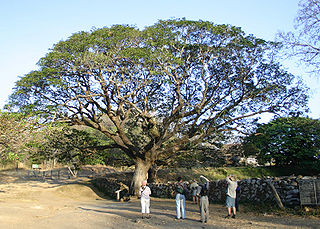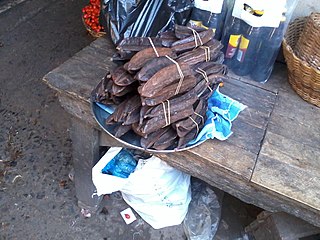
Afzelia is a genus of plants in family Fabaceae. The thirteen species all are trees, native to tropical Africa or Asia.

Brachystegia is a genus of tree of the subfamily Detarioideae that is native to tropical Africa.

The subfamily Detarioideae is one of the subdivisions of the plant family Fabaceae (legumes). This subfamily includes many tropical trees, some of which are used for timber or have ecological importance. The subfamily consists of 84 genera, most of which are native to Africa and Asia. Pride of Burma and tamarind are two of the most notable species in Detarioideae. It has the following clade-based definition:
The most inclusive crown clade containing Goniorrhachis marginataTaub. and Aphanocalyx cynometroidesOliv., but not Cercis canadensisL., Duparquetia orchidaceaBaill., or Bobgunnia fistuloides(Harms) J. H. Kirkbr. & Wiersema.
Bussea is a genus of flowering plants in the legume family, Fabaceae. It includes seven species of trees and occasionally shrubs native to sub-Saharan Africa, ranging from Guinea to Ghana in West Africa, from Gabon and Angola to Tanzania and Mozambique in central Africa, and to Madagascar. Habitats include seasonally-dry tropical forests and thickets, moist semi-deciduous forests, and evergreen rain forest.

Dialium is a genus of flowering plants in the family Fabaceae, subfamily Dialioideae. Velvet tamarind is a common name for several species. The genus includes 37 species which range from the tropical Americas to sub-Saharan Africa, Madagascar, India, Indochina, and western Malesia.

Pachyelasma is a genus of flowering plants in the legume subfamily Caesalpinioideae. It contains only one species, Pachyelasmia tessmannii, which is native to central Africa.
Stachyothyrsus is a genus of flowering plants in the legume family, Fabaceae. It belongs to the subfamily Caesalpinioideae. It includes two species native to tropical Africa.

Griffonia is a genus of central African flowering plants in the legume family, Fabaceae. It belongs to the subfamily Cercidoideae. Griffonia is known to have a high concentration of 5-HTP in its seeds.
Lebruniodendron is a genus of flowering plants in the family Fabaceae. It belongs to the subfamily Detarioideae. It contains a single species, Lebruniodendron leptanthum, a tree native to west-central tropical Africa – Cameroon, Gabon, Republic of the Congo, and Democratic Republic of the Congo. It grows in Guineo-Congolian forest.
Oddoniodendron is a genus of flowering plants in the family Fabaceae. It includes six species of trees native to west-central tropical Africa, including Cameroon, Gabon, Republic of the Congo, Cabinda, and Democratic Republic of the Congo. They grow in lowland tropical rain forest. It belongs to the subfamily Detarioideae.
Scorodophloeus is a genus of flowering plants in the family Fabaceae. It includes three species of trees native to tropical Africa, ranging from Cameroon to the Democratic Republic of the Congo, Kenya, and Mozambique. Habitats include tropical lowland rain forest and seasonally-dry forest, scrub forest, and wooded grassland, often along river banks. It belongs to the subfamily Detarioideae.

Samanea is a genus of flowering plants in the family Fabaceae. It includes four species of trees native to the tropical Americas, ranging from Belize to Paraguay, and to the Democratic Republic of the Congo in central Africa. Habitats include tropical moist evergreen and seasonally-dry deciduous forest, woodland, and wooded grassland. It belongs to the mimosoid clade of the subfamily Caesalpinioideae. The type species is Samanea saman from South America.
Cylicodiscus is a genus of flowering plants in the family Fabaceae. It includes a single species, Cylicodiscus gabunensis, a tree native to the rain forests of western and west-central Africa, ranging from Côte d'Ivoire to Central African Republic and Republic of the Congo.

Fillaeopsis is a genus of flowering plants in the family Fabaceae. It belongs to the mimosoid clade of the subfamily Caesalpinioideae. It contains a single species, Fillaeopsis discophora. It is a tree native to Nigeria and west-central Africa. It is a tree of the Guineo-Congolian forest, where it grows up to 130 feet (40 m) tall.

Leptoderris is a genus of flowering plants in the family Fabaceae. It includes 22 species native to tropical Africa, ranging from Senegal to Tanzania, Malawi, Zambia, and Angola. It belongs to the subfamily Faboideae.

Platysepalum is a genus of flowering plants in the family Fabaceae. It includes 13 species of small trees, shrubs, or lianas native to tropical Africa, from Senegal to Tanzania and south to Angola and Mozambique. Most species are native to the Guineo-Congolian forests of west and west-central Africa, and one is native to the tropical Zanzibar-Inhambane coastal forests of Africa's eastern coast. Habitats include tropical rain forest and seasonally-dry lowland forests, often in disturbed areas. It belongs to subfamily Faboideae.
Rhynchotropis is a genus of flowering plants in the legume family, Fabaceae. It includes two species of herbs native to the Democratic Republic of the Congo, Angola, and Zambia. Typical habitats include seasonally-dry tropical woodland and wooded grassland in the northern Zambezian region, often in seasonally-damp or open sandy and rocky areas. It belongs to tribe Indigofereae of subfamily Faboideae.

Tetrapleura is a genus of flowering plants in the mimosoid clade of the family Fabaceae. It includes two species of trees native to sub-Saharan Africa, ranging from Senegal to Kenya and Tanzania, and south to Angola. They grow in tropical lowland rain forest, secondary thicket, and fringing forest in the Guineo-Congolian forest and Lake Victoria basin.
Baphiastrum is a genus of flowering plants in the legume family (Fabaceae). It includes a single species, Baphiastrum brachycarpum, a liana native to west-central Africa. It grows in Guineo-Congolian forest in Cameroon, Gabon, Republic of the Congo, Central African Republic, and Democratic Republic of the Congo.
Aubrevillea is a genus of flowering plants in the family Fabaceae. It belongs to the mimosoid clade of the subfamily Caesalpinioideae. It includes two species of trees native to west and central Africa, ranging from Senegal to Democratic Republic of the Congo.










